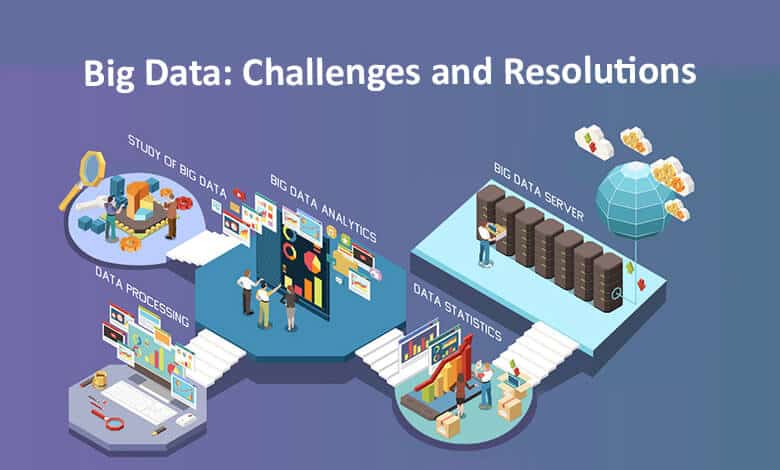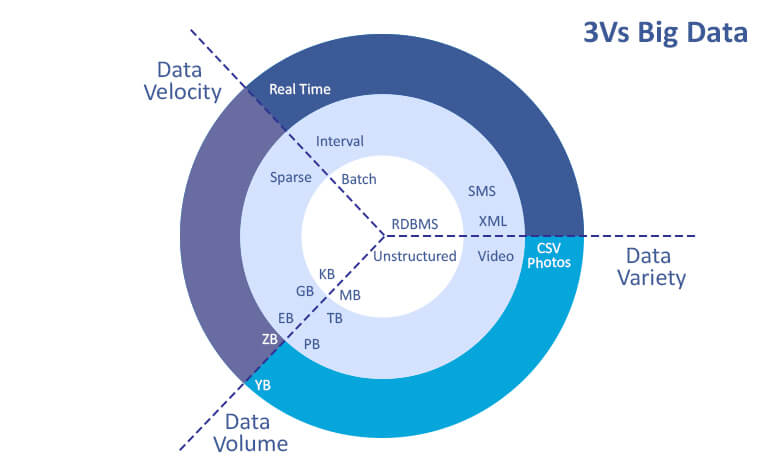Data, in the present times, has become one of the most crucial functional components of all organizations across business domains. If you analyze customer data well, tons of data in the form of customer logs, sales figures, stakeholders and business transactions are generated daily.
Needless to say, data is the fuel that drives businesses. And to support organizational strategies and decision-making processes well, there is no alternative to data. Contrary to common notions, data isn’t always supposed to be complicated.
The World of Big Data
Talking about data, there’s something called big data and data analysis, both of which have become quite a rage in most IT-related organizations, and business sectors. However, what one business might refer to as big data might be highly different for some other organization, or even within the same organization in the next few years. In much the same way, large multinationals have a different understanding of analysis in big data, compared to any start-up.
Usually, experts defined data based on three important ‘V’s.
- The first is ‘volume’. Thanks to trends like social media eCommerce, mobility and Internet of Things (IoT), bulk information is now getting generated, and several companies are utilizing them to the best of their capacities.
- The second is ‘velocity. A good organization must generate new data at a high speed. Also, the response must be made in real-time. If this is established, then the firm is said to have velocity linked to big data.
- Lastly, the data’s ‘variety’ must exhibit features of big data. In other words, there should be storage of email messages, images, videos, presentations, word processing documents, and data inside structured RDBMes or ‘relational database management system’.
The Dependency on Big Data
Problems with big data analytics are not uncommon, and the role of big data in this regard has been paramount in propelling businesses and expanding their growth. What is even better is that almost all sectors are gradually realizing that the impact of big data is and will be felt throughout the globe.
Using big data, you can enable new products to function, reduce the time to market and also streamline certain operational rates. However, enterprises these days experience several big data challenges at every point, even while the work in firms is in progress. Data professionals hence must work in a manner that meets the needs of timeliness, performance, security, scalability and data governance.
Not to miss out on the implementation costs, since they’re more than likely to go out of control! It is for this reason enterprises should figure out big data and data analysis impacting businesses in the very first place.
Challenges of Big Data and Ways to Address Them
Not just for data integration in big data, but there are plenty of data problems and solutions should businesses be aware of, and how to address issues emerging out of them.
Sorting out Large Chunks of Data
The term ‘big’ indicates huge volumes of data present in disparate zones and platforms. Experts have pointed out that the initial challenge for any enterprise is to manage large data sets that should be extracted from ERP and CRM systems and several other data sources, into something more manageable and structured.
To start, plan an infrastructure that would permit incremental changes’; for big changes would create new issues. If you get an idea about the exact load of data getting collected, narrowing down on insights by making few tweaks and adjustments would always be possible.
Detecting and Repairing Data Quality Issues
Just in case data quality issues occur inside big data systems, then the artificial intelligence applications and analytics algorithms built on big data can produce bad output. The problems can manifest into something bigger and far more difficult to audit, if you analyze customer data. For example, ‘Bunddler’, an online marketplace utilized big data for personalized experiences.
As a result, growth patterns were visible in the company, and new trends monitored. Even effective data quality management was a potent issue. Experts reveal that typos and duplicate entries are common. To ensure accuracy, having an intelligent data identifier that sorts out the differences and reports is important. Doing this has helped many firms improve their quality of work, after analyzing the data.
Managing Data Integration Complexities
Data collection is a challenging ordeal. Resorting to big data platforms will resolve issues of gathering and storing huge amounts of data. To assert that the enterprise has maintained integrity in data stores, it must affirm that the data reserves are constantly getting updated. This entails proper maintenance of access to several data sources and also big data integration strategies.
Most firms use data lakes as repositories for chunks of big data collected from a wide pool of sources. Few business domains also produce data that becomes important for joint analysis. If you wish to ensure optimum ROI on projects related to big data, start developing a strategic approach to the process of data integration in big data.
Efficiency and Cost-Effectiveness of Scaling Big Data Systems
It will be a complete waste of time and money to store big data if there’s no proper strategy for using it. Organizations must understand that big data analytics begin right at the data ingestion stage.
The curation of the data repositories at firms and enterprises implies consistent retention policies must be implemented. This works true especially if you feel the need to eliminate prior information, and get access to new data that will be much more relevant in the market. It’s always recommended that data management teams plan out types, schemes and uses of data, before deciding to deploy big data systems. Even a generic data lake having the correct data structure will help in reusing data cost-effectively. That’s exactly why firms must hire big data specialists carefully.
Choosing and Evaluating Big Data Technologies
Most data management teams contain a mix of big data technologies that one can choose from. As a result, multiple tools often overlap, as far as capabilities are concerned. Professionals often say that considering the present and future needs for data will always make sense.
This could include cloud applications, mainframes and third-party data services. After that, teams can evaluate the complex data preparation abilities meant for machine learning, AI and several other modern analytics systems. Not to forget- problems with big data analytics can occur, so the need to plan where data might be processed is equally important.
Producing Business Insights
Data teams must emphasize the tech part of big data and not the outcomes only. Unfortunately, most firms pay less attention to what must be done with the data. It’s not enough to merely analyze customer data. To generate invaluable business insights from big data apps in organizations, you must consider scenarios like identifying important predictions, creating KPI- based reports and also making recommendations.
To ensure that the effort put in is top-notch, inputs from a rich mix of statisticians, business analytics professionals and data scientists, combined with the expertise of machine learning can work wonders!
Recruiting and Retaining People Having Adequate Big Data Skills
Almost every senior professional associated with enterprises and IT firms would agree that to hire big data experts having the necessary skills, at least for big data software development is indeed a challenge. And this is one trend that’s unlikely to dissipate anytime soon!
Post-2020, the demand for cloud architects and data scientists have escalated like no other. To fill these positions, formulate a workable strategy, like partnering with certain software development services companies. A second strategy would be to collaborate with the HR to detect and then address any possible gaps in the existing big data talent. Above everything, it’s important to establish a proper culture that would retain the correct talent. Once you find the right team, several tasks will be streamlined- like evaluating severity, estimating risks and also resolving an array of big data challenges.
Keeping Costs Under Check
Surprisingly, several enterprises make the common mistake of using the present data consumption metrics to estimate the probable costs of the new infrastructure meant for big data. Sadly, this doesn’t work! Several companies often underestimate the growing demand for computing resources to access richer data set reserves.
This is particularly accentuated by the cloud, which make these platforms appear richer. Opting for an on-demand pricing model can also add up to the costs. To minimize that, opting for fixed resource pricing is a good technique. However, there’s no guarantee that the problem will be solved.
Tracking Big Data Environments
As big data applications keep growing across systems, data governance issues are becoming difficult. New cloud architectures have enabled most firms to store all the data collected, so the issue is aggravated furthermore.
Any information that is protected well can also enter inside many applications. If you learn how to treat data as a product with the aid of a support engineer, then it would be a good way to begin. The more time you invest in identifying, and then managing big data governance issues, the more you will understand how to provide self-service access easily.
Data Context and Use Cases to Be Understood
Several enterprises often overemphasize technology without deciphering the very context of the data or its uses. Teams are often led to believe that effort must be put on big data storage architectures, security issues and more. But very few people think about on boarding users. The thought must be channelized into something like refining the data or data analysis in big data. All those who are closest to technology must manage risks well. That way, limitations can be understood better.
Wrapping Up…
Startups should ensure that big data solutions work well for their respective firms, and help in saving money too. Besides, with a support engineer, algorithms of the big data and its utility for up scaling in the near future can be designed. Don’t forget to get all such necessary plans for both maintenance and support of your system. This way you can address all such data-related changes. And lastly, ensure that systematic performance audits are conducted in the system to detect weak spots, if any. While challenges are likely to vary with time, executing apt solutions is necessary. And since big data is here to say, the faster businesses understand these challenges and work out solutions – the better it will be.
Summary
Most firms and business organizations are now resorting to Big Data for multiple reasons. It’s here to stay, and will definitely pave the way for better integrations and support at work. The need for a well-executed big data strategy can bring an array of benefits that will suit the current demands of the industry. And with time, more recruiters will figure out the implications of hiring experts who can handle big data issues in a jiffy! As long as enterprises identify the challenges associated with big data, it will make sense how trained, and certified professionals will help in the long run.


